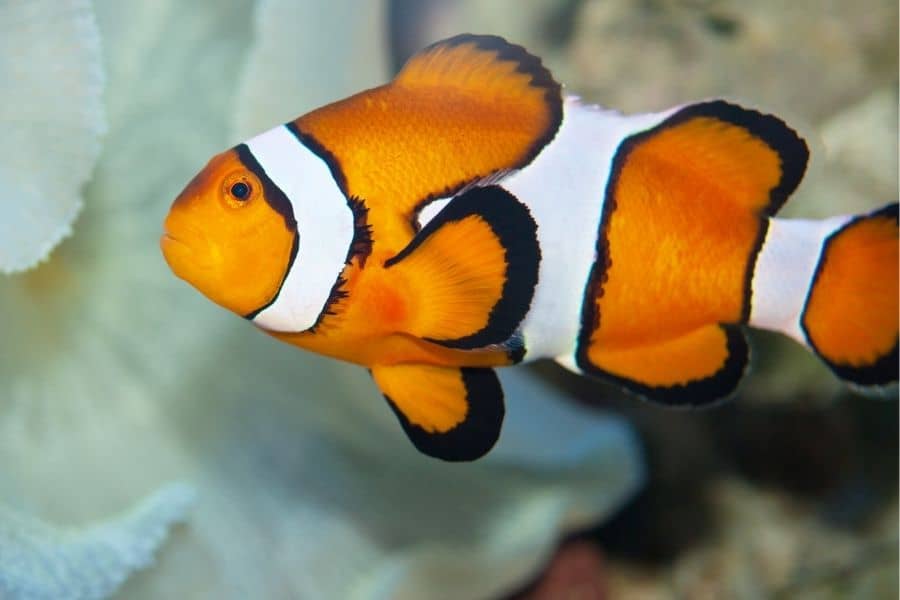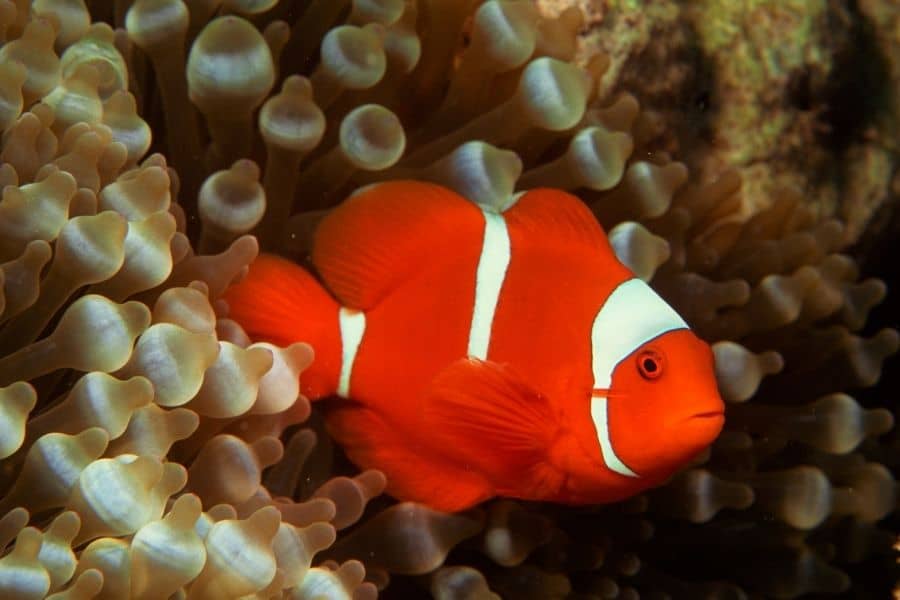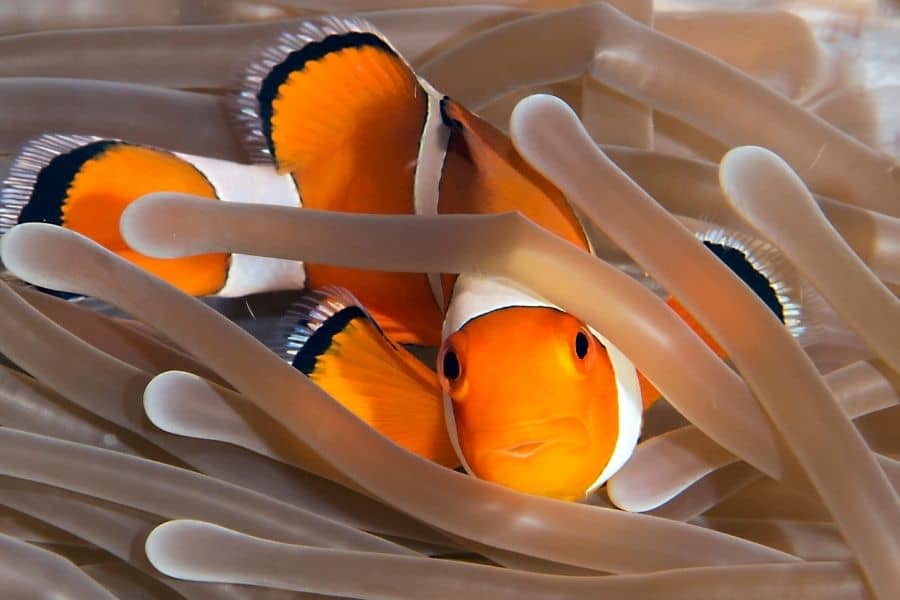Clownfish is an iconic fish in the saltwater aquarium. Every aquarium owner dreams of owning a Nemo in their saltwater aquarium because of their unique characteristics. Lets see How Big Do Clownfish Get?
However, many fish owners have doubts about keeping a clownfish in their tank. One such doubt is their size when matured.
How Big Do Clownfish Get
Jump To
- 1 How Big Do Clownfish Get
- 2 How Long Does It Take For A Clownfish To Grow To Full Size?
- 3 How Big Do Clownfish Grow In Captivity Vs. Ocean?
- 4 Factors Affecting Clown Fish Size
- 5 How to Make Them Grow Fast
- 6 Does Anemone Effect Clownfish Growth
- 7 Clownfish Baby Feeding Guide
- 8 Where do clownfish lay their eggs?
- 9 Clownfish Larvae Food
- 10 Related Questions
- 11 Source
A clownfish grows up to 4.3 inches in length but this matured size may change with different clownfish species.
There are six complexes of clownfish which are grouped due to their size, patterns, and characteristics.
Among these six complexes, the Maroon clownfish complex grows larger than other clownfish.
Maroon clown can reach a length of 6 inches. On the other hand, the smallest clownfish species (Percula clownfish) barely reach three inches in length.

| Clownfish Type | Size | How Fast They Grow |
|---|---|---|
| Common Clownfish | 4.3 Inches | ½ -1 inch each year. |
| Maroon Clownfish | 6 Inches | 1 inch per year. |
| Black Clownfish | 3 Inches | ½ -1 inch each year. 2 to 3 years to fully grown size. |
| Cinnamon Clownfish | 4.7 Inches | 1 inch per year. |
| Tomato Clownfish | 5.5 Inches | 1 inch per year. |
| Clarkii Clownfish | 4 Inches | ½ -1 inch each year. |
| Pink Skunk Clownfish | 4 Inches | ½ -1 inch each year. |
| Saddleback Clownfish | 4.7 Inches | 1 inch per year. |
| Orange Storm Clownfish | 3 Inches | ½ -1 inch each year. 2 to 3 years to fully grown size. |
How Long Does It Take For A Clownfish To Grow To Full Size?
Average to small-sized clownfish takes about 2 to 3 years to grow to its full size. Larger-sized clownfish take a little longer than that. They take about 3 to 5 years to reach their maximum size.
Read Can Clownfish Change Gender? Interesting Facts You Must Know
How Big Do Clownfish Grow In Captivity Vs. Ocean?
There is no difference in size in captivity bred clownfish and wild clownfish.
The only difference is that wild clownfish have more vivid colors than captive-bred clownfish because of unlimited space, natural food, and their preferred habitats.
Otherwise, both clown types grow up to four to five inches long. However, wild clownfish live more than captive-bred clownfish, but if you try to keep wild clownfish in an aquarium, their lifespan will decrease dramatically due to stress.
Factors Affecting Clown Fish Size
Clownfish size can change due to several factors. In an aquarium, there is always a larger dominant clown than other fish. We will talk about it in a minute. Below are the factors affecting clown size.
Food
Clownfish are omnivore fish, but they prefer meaty food rather than plant matter. In the wild, they mostly eat zooplankton, copepods, tunicate larvae, shrimps, and so on.
So, clownfish mostly need carnivore food to grow properly. If you fail to provide a balanced diet, they will have a nutrient deficiency; hence, they may have stunted growth.
Water Condition
Clownfish need saltwater to live in an aquarium. The water temperature should be at 72-78°F, and the Ph level should be at 8.0 to 8.4.
The salinity should be between 1.021 and 1.026, the ammonia level at 0, and nitrates and nitrites levels less than .2 ppm.
Changes in these water conditions affect the growth rate of clownfish by weakening their immune system.
Mating
Usually, clownfish don’t reach their full size until they are ready to mate. Interestingly, all the clownfish were born as males.
When they are ready to mate, one fish get dominant and change its sex to female.
This female fish is always the dominant fish, and it grows bigger than other fish. The male fish always keep an 80% growth rate than females even though they receive enough food.
Read How Much Do Clownfish Cost By Type? Must Know Things
How to Make Them Grow Fast
To be honest, you cannot speed up clownfish growth by doing anything. Clownfish are naturally slow growers.
They will grow one inch per year at most, and if you observe them every day, you may not notice any change of size at all.
However, if you provide them with good quality water with the required lighting and natural habitats, your fish will thrive well because of their stress-free environment.

Does Anemone Effect Clownfish Growth
No. Anemone doesn’t affect clownfish growth in any way. It works the other way. Clownfish actually helps Anemone to stay safe from anemone predators like butterfly fish by chasing them away.
Further, clown help Anemone to breathe at night by being extra active during the night.
The protection and help anemones get from clownfish provide safety and shelter to the clownfish inside Anemone’s tentacles.
However, each clownfish species prefer different Anemones and some Anemones like conde Anemones actually eat clown as they see the clownfish as a food, not a host.
So, when keeping both Anemone and clown, you should check whether they suit each other or not.
Clownfish Baby Feeding Guide
Raising clownfish babies is a complicated task. You need to be careful when the eggs hatch until the babies grow to a certain age.
Taking care of clown babies is not recommended for beginner fish keepers as it takes more time, dedication and money.
Where do clownfish lay their eggs?
Clownfish lay their eggs on a small patch of rock near the area they spend most of their time.
Before laying their eggs, clownfish clean that rock for about a week so you can be sure that they are getting ready to lay their eggs.
In aquariums, hobbyists provide clay pots or tiles to lay eggs as they are easy to remove and handle.

Before Eggs Hatching
Clownfish eggs usually take about 6 to 8 days to hatch. Once the eggs hatch, you should immediately turn off all the filters to avoid the larvae filtering through the filters.
To do this, you should track the egg hatching time from the day clownfish lay eggs. Eggs usually hatch in the night, so it will be enough you observe the eggs in the night.
Another hint that the eggs are going to hatch is that eggs will turn to silver. When the clownfish eggs are ready to hatch, you can clearly see the eyes of larvae clearly inside.
If you see these changes, check them closely because larvae may die because of filters due to their tiny size if not turned off the filters.
How many eggs does a clownfish lay?
A female clownfish lay between 100 to 1500 eggs in a single spawning event, and they spawn every two weeks.
However, the average pair producing is somewhere around 400 to 500.
Larger clownfish species like maroon clownfish usually lay about 1000+ eggs, while smaller clown species lay only a couple of hundreds.
Clownfish Larvae Food
In the wild, clownfish larvae eat plankton and other nearly microscopic plants and animals. You should provide food that closely resembles their original food.
You should give live food as they will not eat dry food in the first few days and will not survive without live foods.
Rotifers are an excellent source of food for Clownfish larvae.
So, culture and maintain rotifers in another tank before breeding your clownfish, as it is vital to provide live food to clown babies.
Feeding Baby clownfish
You should feed rotifers in the first ten days of baby clownfish life as they do not eat freeze or dry food in the larvae stage.
You can try providing them with newly hatched brine shrimp within five days, but it’s not necessary. After ten days, you can begin feeding them with dry food.
The first dry food you offer should be “TDO – A” (Top Dressed Otohime). It is a high-quality fish food from Japan.
When starting to feed with TDO – A, you should continue to provide the baby clownfish rotifers and slowly reduce the amount when your baby fish starts to eat TDO – A.
Once you are sure that your fish are eating TDO – A, you can stop feeding them rotifers.
After about four days of TDO – A feedings, mix TDO – A with TDO – B1. Feed this mixture for about three days, then feed only TDO – B1 until the fish are about two weeks old.
Once they get used to TDO –B1, you can begin introducing foods such as ground flakes and pellets. You can ground this food with a mortar and pestle, which are inexpensive and available in local pharmacy stores or online.
As they continue to grow, you can feed them with more coarsely ground pellets or flakes. You can also provide them with TDO – C2.
Related Questions
How Big Do Maroon Clownfish Get
Maroon clownfish grow up to 6 inches long. Actually, they are the biggest species of clownfish we have on the list and one of the most aggressive clownfish species out there.
They usually don’t let other clownfish live in their territory unless they are a mated pair. When the female fish is in a bad mood, they tend to relentlessly pick at the smaller male until the male fish dies.
Can Clownfish Be Black And White?
Yes. The Black clownfish, also known as Darwin clown, is a variant of regular Ocellaris clown (or common clownfish) with black and white colors.
They are entirely black with three white stripes and grows a little bigger than the regular Ocellaris clownfish.
Source
Buston, P., 2003. Size and growth modification in clownfish. Nature, 424(6945), pp.145-146.
